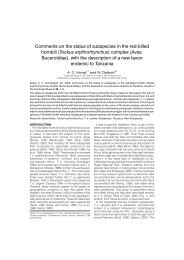EAZA Hornbill Management and Husbandry Guidelines
EAZA Hornbill Management and Husbandry Guidelines
EAZA Hornbill Management and Husbandry Guidelines
You also want an ePaper? Increase the reach of your titles
YUMPU automatically turns print PDFs into web optimized ePapers that Google loves.
2 Captive population management<br />
2.1 Identification<br />
Conclusions on this topic were made during the International <strong>Hornbill</strong> Workshop 1997 in<br />
Malaga (Spain), <strong>and</strong> were originally summarized by Christine Sheppard.<br />
Large hornbills are rarely individually-marked in zoos because they are dimorphic <strong>and</strong><br />
usually kept in pairs. However, if future, more intensive, population management results<br />
in more hornbill exchanges between institutions, all individuals should be readily<br />
identifiable. Transponders are useful, but can migrate or fail, <strong>and</strong> are unreadable unless a<br />
bird is very near the transponder reader. There have been no reports of significant<br />
problems with any type of metal leg b<strong>and</strong>. Therefore it is recommended that these two<br />
marking systems, b<strong>and</strong>s <strong>and</strong> transponders, are used simultaneously.<br />
Transponders should be implanted in a hornbill’s right pectoral muscle. If possible, a<br />
second transponder should be implanted as a back up. The second transponder should be<br />
implanted in the left pectoral muscle as two transponders implanted in the same site can<br />
give hybrid readings. All hornbills should be ringed below the tarsometatarsal joint with<br />
metal b<strong>and</strong>s engraved with identification numbers. Males should preferably be b<strong>and</strong>ed on<br />
the right, females on the left. While “closed” rings or b<strong>and</strong>s, which cannot be removed<br />
without being destroyed, should ideally be used, other b<strong>and</strong>s can be used when necessary.<br />
Young hornbills should be b<strong>and</strong>ed as soon as possible without disruption to management.<br />
Transponder <strong>and</strong> b<strong>and</strong> numbers <strong>and</strong> site of placement on the body should be included in<br />
the bird's records.<br />
A comprehensive list of ring sizes <strong>and</strong> appropriate age to fit closed rings should be<br />
compiled for a future edition of hornbill guidelines or as a supplement to the guidelines.<br />
2.2 Morphology <strong>and</strong> sex determination<br />
Males are equal to, or up to 17% heavier, than females in mass. Wing length of males is 1<br />
to 21 % greater <strong>and</strong> bill length 8 to 30% greater than in females. Male casques are always<br />
larger than female casques. The bill <strong>and</strong> the casque probably have a role in<br />
communicating age, sex <strong>and</strong> status of an individual in conjunction with changes in eye,<br />
skin <strong>and</strong> plumage coloration (Kemp, 1995). Examination of the degree of dimorphism in<br />
various features through out the hornbills (Kemp 1995) suggests that species that are<br />
highly dimorphic in coloration are often not extremely dimorphic in casque volume,<br />
while many that are very dimorphic in casque volume are relatively monomorphic in<br />
coloration.<br />
10




